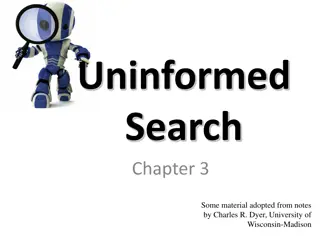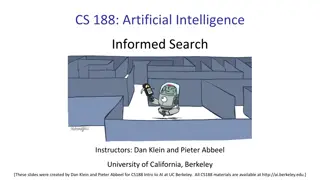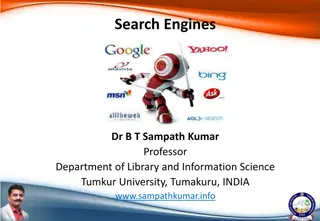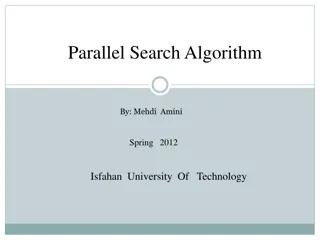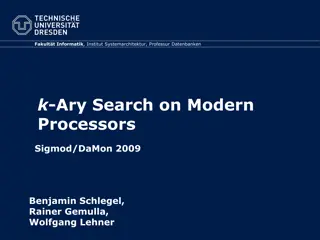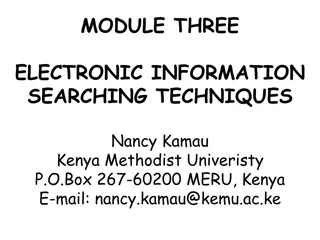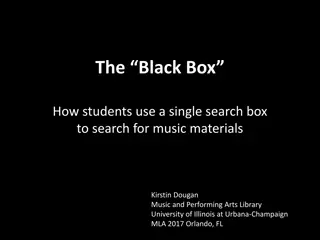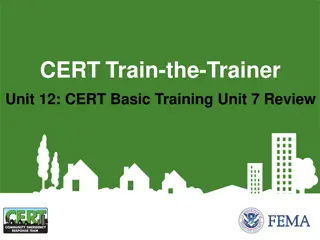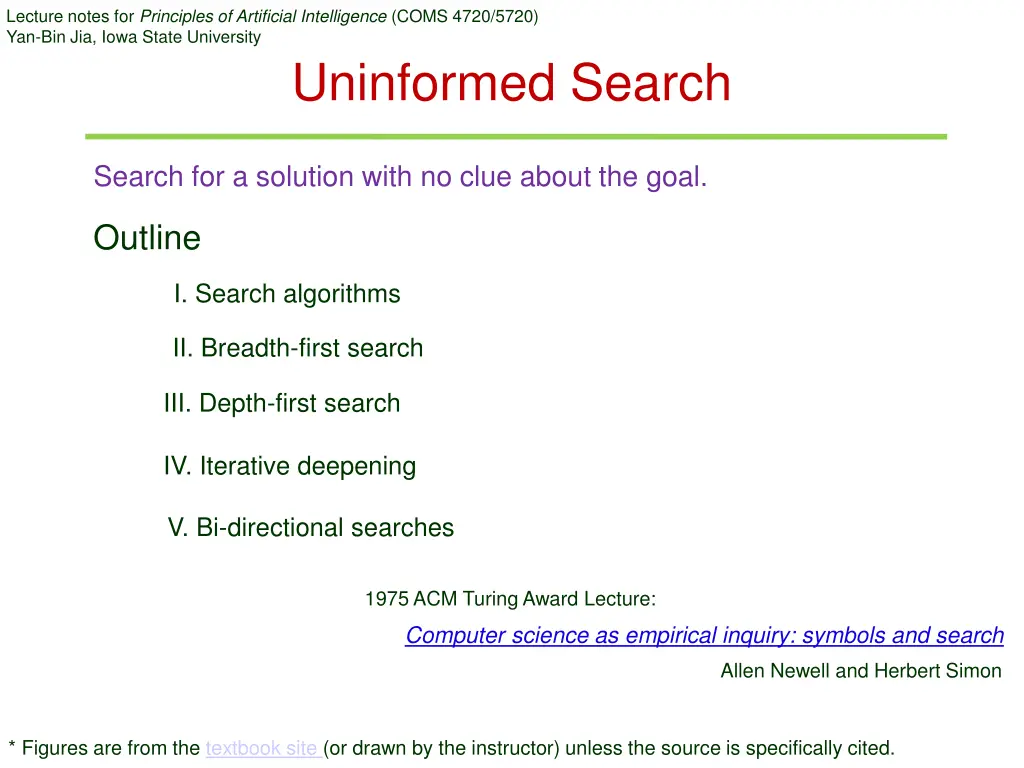
Uninformed Search Algorithms for Artificial Intelligence
"Explore the principles of artificial intelligence through uninformed search algorithms such as breadth-first, depth-first, iterative deepening, and bi-directional searches. Learn about tree search, best-first search, and the importance of detecting repeated states in solving problems effectively."
Download Presentation

Please find below an Image/Link to download the presentation.
The content on the website is provided AS IS for your information and personal use only. It may not be sold, licensed, or shared on other websites without obtaining consent from the author. If you encounter any issues during the download, it is possible that the publisher has removed the file from their server.
You are allowed to download the files provided on this website for personal or commercial use, subject to the condition that they are used lawfully. All files are the property of their respective owners.
The content on the website is provided AS IS for your information and personal use only. It may not be sold, licensed, or shared on other websites without obtaining consent from the author.
E N D
Presentation Transcript
Lecture notes for Principles of Artificial Intelligence (COMS 4720/5720) Yan-Bin Jia, Iowa State University Uninformed Search Search for a solution with no clue about the goal. Outline I. Search algorithms II. Breadth-first search III. Depth-first search IV. Iterative deepening V. Bi-directional searches 1975 ACM Turing Award Lecture: Computer science as empirical inquiry: symbols and search Allen Newell and Herbert Simon * Figures are from the textbook site (or drawn by the instructor) unless the source is specifically cited.
I. Tree Search Expanded node Frontier node (unexpanded) Node to be generated next Frontier
Generated Search Trees Superimpose a search tree over the state space graph and find a path from the initial state to the goal state. Arad Bucharest Which node on the frontier to expand next?
Best-First Search Choose a node ? with minimum value of some evaluation function?(?). Return it if its state is a goal state. Otherwise generate child nodes and add them to the frontier. 3 1 6 7 2 4 5 8 PARENT 3 2 1 6 Node structure: Node 7 4 ACTION = ?? PATH-COST = 4 node.STATE STATE 5 8 node.PARENT node.ACTION: action applied at the parent node to generate this node node.PATH-COST: total cost of the past from the initial state to this node. ? ?
More on Data Structure 3 1 6 7 2 Frontier: IS-EMPTY(frontier) 5 4 8 PARENT POP(frontier) 3 2 1 6 Node 7 4 TOP(frontier) ACTION = ?? PATH-COST = 4 STATE 5 8 ADD(node, frontier) Three kinds of queues: A priority queue pops the node with the minimum cost. A FIFO queue pops the first added node (used in BFS). A LIFO queue pops the most recently added node (used in DFS).
Best-First Search Algorithm // states on the frontier // states // that have been reached // state ? is reached at the node child. Can implement BFS and DFS.
Repeated State Failure to detect repeated states can turn a solvable problem into an unsolvable one. Keep only the best path to each state.
Performance Measures Completeness: Is the algorithm guaranteed to find a solution whenever one exists? The state space may be infinite! Cost optimality: Does it find a solution with the lowest path cost of all solutions? Time complexity: Physical time or the number of states and actions. Space complexity: Memory needed for the search. ? + ? ?
Depth and Branching Factor The measure in terms of ? + |?| is appropriate when the graph is explicit. But often implicit graph representation of a state space in AI: the initial state actions a transition model Initial state Optimal solution path (? + 1 nodes) Accordingly, complexity is measured in terms of ?: depth (number of actions in the optimal solution) ?: maximum number of actions in any path ? successors ?: branching factor (number of successors of a node). Goal state
Infinite State Space Knuth s conjecture: Any integer > 4 can be reached from 4 via a sequence of square root, floor, and factorial operations. 4 4! ! = 5 4! 4! ! Algorithm Repeatedly applies the factorial operator . 4! !! * Photo from https://amturing.acm.org/byyear.cfm.
II. Breadth-First Search Uninformed search: No clue about how close a state is to the goal. Expand the root first, then all its successors, next their successors, and so on. Systematic search. Complete even when the state space is infinite. Always finds a solution with a minimum number of actions.
BFS Algorithm Can call BEST-FIRST-SEARCH by letting the evaluation function ?(?) = node depth. Not efficient: Use a FIFO queue and adopt early goal test (when a node is generated).
Time and Space Complexities BFS on a uniform tree where every node has ? successors. branching factor ? nodes at depth 1 generated by the root. Each node at depth 1 generates ? nodes. ?2 nodes at depth 2. And so on. Solution at depth ? #nodes = 1 + ? + + ?? = ?(??) =??+1 1 ? 1(assuming ? > 1) Time & space complexities (since every node remains in memory) Only small search problems are solvable due to exponential time complexity. Memory is a bigger issue than time.
Time and Memory Requirements for BFS Tree search: ?(??) Depth Nodes Time Memory 2 110 .11 milliseconds 107 KB 4 11,110 11 milliseconds 10.6 MB 6 1.1 seconds 1 GB 106 8 2 minutes 103 GB 108 10 3 hours 10 TB 1010 12 13 days 1 PB 1012 14 3.5 years 99 PB 1014 16 350 years 10 EB 1016 ? = 10 Graph search is preferred since its time and space are proportional to the size of the state space (often less than ?(??)).
Uniform-Cost Search (Dijkstras Algorithm) Spreads out in waves of uniform path-cost. Rimnicu Vilcea (80) Fagaras (99) Fagaras (99) Pitesti (80 + 97 = 177) Pitesti (177) Bucharest (99 + 211 = 310) Bucharest (177 + 101 = 278< 310)
Uniform-Cost Search: Completeness and Complexity Completeness: systematic exploration of all paths no chance of being trapped in one. Optimality: following from that of Dijkstra s algorithm. Complexity: guided by costs not depth ?(?1+ ? /? ) ? : cost of the optimal solution ?: lower bound on the costs of all actions ?? possible (e.g., exploring futile paths of small steps first) = ??+1 if all actions have the same cost.
III. Depth-First Search Expand the deepest node in the frontier first. Implementable as a call to BEST-FIRST-SEARCH by setting ?(?) to the negative depth.
Non-Optimality of DFS Returns the first solution it finds, even if it is not the cheapest. ?0 Optimal solution ?? Goal state
Inefficiency of DFS May expand the same state many times via different paths, and even systematically the entire space. ?? ?0 Goal ?? May get stuck in an infinite loop in a cyclic state space. ?1 ?? ?0 ?? Check each node for cycles.
Incompleteness of DFS Can go down an infinite path forever. ?0 ??
Why Consider DFS? Small memory for problems admitting tree-like search. No need for a table of reached nodes. depth 0 Small frontier. Search time ?(#nodes). Memory consumption ? ?? . depth ? branching factor (# successors) maximum depth Workhorse of constraint satisfaction, logic programming, etc.
Depth-Limited Seach To avoid exploring an infinite path, add a depth limit ?. depth 0 All nodes at depth ? are considered dead ends even if they have successors. Time: ?(??) depth ? Memory: ?(??) Performance sensitive to the choice for ?. Not expanded What strategy to address this?
IV. Iterative Deepening Search Pick a good value for ? by trying all values: 0, 1, 2, and so on. ? = 0 ? = 1 ?: branching factor ? = ? Combines the benefits of DFS and BFS: Completeness and optimality of BFS. Small memory requirement of DFS (only the current search path is stored). Why not store all the nodes at depth ? before moving on to depth ? + 1? ?(??) memory!
IDS Pseudocode DEPTH-LIMITED-SEARCH returns a goal state if it s found failure if it has exhausted all nodes and is certain no solution exists at any nodes. cutoff if no solution has been found for the current search limit ? (but there might be a solution at some depth > ?.
Time and Memory of IDS Case 1 Goal state is found at depth d. ? = 0 Nodes at the bottom level are generated once. Nodes at the next-to-bottom level are generated twice. ? ? = 1 Goal ? = ? Time ~ #nodes ??+ 2?? 1+ + ? 1 ?2+ ?? = ?(??) Memory:?(??) Same as BFS! Case 2 Goal state is not found in a finite state space. Time?(??) Memory?(??) ?: maximum number of actions in any path Modest memory requirement like DFS.
V. Bidirectional Search Goal state Initial state ?/2 ?/2 forward search backward search Motivation: ??/2+ ??/2 ?? ? ? forward Needs to reason backwards: backward ? is a successor of ? in the backward direction (i.e., a predecessor in the forward direction).
Backward Reasoning Easy if all the actions are reversible. 8-puzzle Finding a route in Romania Difficult to conduct if the goal is abstractly specified. 8-queen * Figure 3.20 in the 3rd edition
Bidirectional Best-First Search Two versions of the problem // Expand node on frontier; check if any child node has a state // already reached in the other frontier.
Comparing Uninformed Search Strategies ?: branching factor (> 1) ?: minimum depth of a solution 1. if ? is finite, and the state space either has a solution or is finite. ?: depth limit 2. if all costs are ? > 0. ?: maximum search tree depth 3. if all costs identical. ? : optimal solution cost 4. if both directions are breadth-first or uniform-cost. ?: minimum action cost






